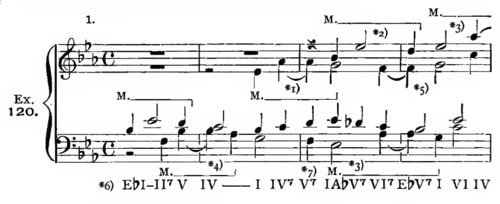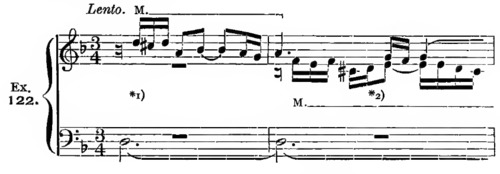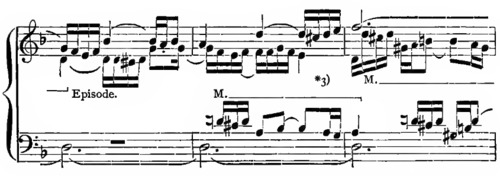CHAPTER VIII.
The Invention for More than Three Voices.
74. As the number of polyphonic voices or parts is increased, the texture assumes a proportionately pronounced harmonic character; and the difficulty of preserving proper balance between the dissonances of friction, inevitable in the “independent conduct” of the parts, and the consonances indispensable to their “harmonious union,” becomes more and more real and severe. Review par. 59, and par. 60.
Details of Four-Voice Polyphony.
75. a. As before, the sum of 4 parts may be successively accumulated by adding contrapuntally first a second voice, then a third, and finally the fourth voice, to the leading part, — in such order as appears most convenient, and generally in brief stages of about five or six beats at a time. Review, thoroughly, par. 61b.
b. Or, probably better and easier, the three other voices may be led more nearly, or exactly, abreast of the leading part, and of each other; their movements will then be controlled directly by the successive harmonic structures, or chords (i.e., the vertical clusters of essential tones, which are to represent the successive rhythmic pulses); and the vital condition of voice-independence must be satisfied at the same time by judiciously disguising these harmonic clusters. Review, thoroughly, par. 61c.
The choice between these two processes will probably be determined by individual disposition; some students will find the “cumulative” process easier, while others will prefer the “harmonic” one.
c. The importance of the Tie, and of parallel movement in 3rds or 6ths between two of the parts, is as great, here again, as in three-voice texture, and must not for an instant be lost sight of. Review, thoroughly, pars. 61d and [par.] 61e; also par. 61f.
d. The rules relative to the conduct of the lowermost part, to the rhythmic conditions of the polyphonic texture, and to the adoption of a temporary leading part, apply without modification also to the association of four contrapuntal parts. Review, thoroughly, pars. 62, [par.] 63, and [par.] 64; also the summary, par. 65. Especial care should be taken to avoid too great density of texture. To this end, it is wise to sustain the rhythm of at least one of the voices as much as possible,— as shown in Ex. 122 (Note *4); and, at all events, to avoid conducting all the parts together in (simultaneous) rapid rhythmic movement, or in any fashion that produces a “jumbled” rhythmic effect.
e. The condition which probably increases most in significance, in this fuller species of polyphonic writing, is that of the Rest; not only because the temporary cessation of one (or more) of the voices conduces to greater variety of volume, and to greater clearness of texture; but also because it facilitates, very materially, the manipulation of the whole. On the other hand, the indispensable discipline of strictly 4-voice Polyphony obliges the student (for a time, at least) to abstain from such frequent use of Rests, — especially protracted omission of one or another of the four parts, — as would reduce the present task to that of the 3-voice texture. Review, particularly, pars. 63b and [par.] 63c.
For illustration of the domination of the harmonic principle, and the methods of preserving voice-independence, etc.:


*1) Last tone of M. lengthened (par. 30a).
*2) Shifted rhythm (par. 31c).
*3) First tone of M. lengthened (par. 30b).
*4) Suspension.
*5) Parallel 6ths in upper, and 3rds in lower, voices (par. 61e).
*6) This line of Roman numerals indicates the harmonic basis; compare with par. 18a to [par.] 18c
*7) The Triad upon the Leading-tone (sometimes marked VII) is an abbreviated form of the Dominant 7th-chord.
*8) From the Well-temp. Clav., Vol. I, Prelude 7, measures 10–15; the student is to continue the analysis, up to measure 24.
*9) From the same Prelude, measures 36–38; continue the analysis, with extreme thoroughness and minuteness, to the end.
*10) The “chord-forms” are here indicated in letters, without regard to the accidentals (which are always determined by the key), or to the chord-names.
*11) All tones foreign to the prevailing chord-form are marked +; it will be observed that they invariably obey the law of inharmonic tones, and progress conjunctly. Compare par. 4a.
*12) These two beats illustrate admirably the fundamental rule of rhythmic relation of the voices (par. 65f).
Observe, also, how effectively the rhythmic movement of the other parts is restrained (by heavy notes) while one part is active.
*13) Indirect resolution of Suspension (Ex. 10).
*14) These beats illustrate a very effective interaction of adjacent parts, whereby one part appears to coöperate with its neighbor in furthering some melodic or thematic purpose of the latter; in this instance the descending scale passes, without a check, from the Soprano into the Alto, and from that into the Tenor, describing a long and powerful line, and unifying the parts without impairing their independence. Compare Ex. 116, Note *5).
Analyze the following specimens of 4-part Polyphony; very minutely, but only with reference to the voice-conduct, — not thematically:
Bach, Well-temp. Clav., Vol. I, Fugue 1, last 7 measures; Vol. I, Fugue 12, last 6 measures; Vol. I, Fugue 14, last 9 measures; Vol. I, Fugue 17, last 8 measures; Vol. I, Fugue 18, last 10 measures.
Bach, Well-temp. Clav., Vol. II, Fugue 5, measures 1–16; Vol. II, Fugue 9, measures 1–9; Vol. II, Fugue 23, measures 14–27.
The Four-Voice Invention.
76. Review par. 37. — When four polyphonic parts are used, they are always named Soprano, Alto, Tenor, and Bass, in analogy with the vocal quartet. Review par. 66a.
The structural designs are somewhat more limited, — in keeping with the other specific limitations of 4-voice Polyphony; hence, while any of the forms already enumerated may be adopted for the 4-voice Invention, the Sectional form is probably the most appropriate and effective.
The First Section, or Exposition.
77. a. The Motive must, as a rule, be brief, comparatively narrow in compass, and of quiet (or at least not too lively) rhythmic character. The following Motives are used by Bach for 4-part development:



See also Ex. 120, Nos. 1 and 120-2; and Ex. 122.
b. The first announcement of the M. may occur in any one of the four parts; and, as usual, one or two, or possibly all, of the other parts may supply auxiliary lines (either contrapuntal, or simply harmonic) until their turn comes to imitate the M. legitimately. Review par. 67a, [par.] 67b, and [par.] 67c.
c. The order of Imitations at the beginning of a 4-voice Invention may be regular; i.e., each successive Imitation may appear in the part nearest (adjacent) to the preceding imitating voice; thus, after Soprano, in the Alto; after Bass, the Tenor; after Alto, either Soprano or Tenor; after Tenor, either Bass or Alto.
But this regularity of voice-succession is by no means necessary in the Invention, and the utmost freedom is exercised in the choice, both of the interval of Imitation, and of the voice in which the Motive is next to appear, — not only at the beginning, but through the entire Exposition. Compare par. 67d; and see also par. 67e.
For illustration:




*1) Motive in Soprano; Alto and Tenor tacent; Bass auxiliary.
*2) Unessential modification of the M., corresponding to par. 33—(1), which see. This form recurs frequently, later on.
*3) Thus far the order of Imitation is regular, as concerns the part-succession, — Soprano, Alto, Tenor. In the following measure the M. appears again in the Alto, and during the next 3 (sketched) measures two other announcements are made, in upper parts, before the Bass announces its legitimate Imitation, in the 9th measure.
*4) Observe, here again, how carefully the inner parts are restrained in their rhythmic movement, by long notes, while the outer parts are active. The same disposition to preserve good balance of motion and to avoid “jumbled” rhythmic effects is evinced throughout. See Ex. 120, Note *12), second clause.
*5) From the Prelude of the “Preludio con Fughetta” in d minor, for the clavichord (Peters ed., 200, No. 6).
78. The remaining Sections of the 4-voice Invention are conducted in the usual manner. Review par. 68; and analyze the following Inventions, in sectional form, very diligently:
The remainder of Example 122.
Bach, English Suite No. I, “Prelude”; introductory cadenza of 2 measures; M. given in Ex. 121, No. 3; Section I ends in measure 9, and is extended by a Codetta of 1½ measures; Section II closes in measure 16, followed by a similar Codetta; Section III extends to 3rd measure from the end, and has the same Codetta, extended. (Compare last two measures with Well-temp. Clavichord, Vol. II, Prelude 19, end.) The texture is frequently 3-voice (compare par. 75e), and the register of the four parts is somewhat obscure, at times.
Bach, Toccata for Clavichord in c minor, measures 12–29; M. given in Ex. 121, No. 4. The rhythm is gradually accelerated.
Bach, Toccata for Clavichord in f♯ minor, second tempo (3-2 time); M. chromatic, first announced in Soprano; Bass has the M. once only, abbreviated.
Bach, Air with 30 Variations (Clavichord); Var. 16, second tempo (3-8 time); chiefly 3-voice texture.
Bach, Fantasia con Fuga in a minor (Clavichord), “Fantasia” (Peters ed. 208, No. 2); Section I, measures 1–12, is purely introductory, containing only allusions to the Motive; it is 5-voice texture, and harmonic in character, and recurs as Section IV (measures 31–42), transposed; recurs again, as Section VI (measures 69–80), transposed; and once more, as final Section (last 12 measures), as a nearly literal da capo. the M. is first announced in Section II (Soprano, measures 11–13, — given in Ex. 121, No. 2), and imitated, chiefly in stretto, during this and the next Section (to measure 31); in Sections V and VII (measures 42 and 80) the rhythm is more or less persistently animated, — somewhat after the manner of par. 70a.
Bach, Well-temp. Clavichord, Vol. I, Prelude 12; the M., 2 beats long, is announced by the Soprano, and then followed by a lyric extension (or episode) before an Imitation occurs, — in Tenor; the Bass is auxiliary, taking no evident part in the thematic announcements; the same is partly true of the Alto, also; there are three Sections, the last one containing (in measures 16–18) a fairly convincing indication of a return to the beginning, and thus imparting the impression of 3-Part Song-form (primary grade).
Bach, Well-temp. Clavichord, Vol. I, Prelude 4; M. one measure Soprano part; the texture is largely 3-voice; there is a strong Dominant cadence in measure 14, which probably resolves the structure into a 2-Part Song-form (primary grade). The manipulation of this M. is extremely ingenious and instructive; unique rhythmic modifications, and the shifted rhythm, occur frequently; analyze carefully.
Bach, Toccata for Clavichord in d minor, measures 15–32; M. 3 beats, in Alto.
Bach, Fantasia con Imitazione, Peters ed. No. 216, Section II ( time); M. undergoes several modifications. Bach, Fantasia, Peters ed. 215, bottom of page 7 to page 10. Same volume, page 22, — first 4 measures introductory; M. in Alto, one measure. Bach, Fantasia, Peters ed. 1959, pages 94 to 97, — first 14 measures introductory. Same volume, pages 99–100 (
time); M. undergoes several modifications. Bach, Fantasia, Peters ed. 215, bottom of page 7 to page 10. Same volume, page 22, — first 4 measures introductory; M. in Alto, one measure. Bach, Fantasia, Peters ed. 1959, pages 94 to 97, — first 14 measures introductory. Same volume, pages 99–100 ( time).
time).
Mendelssohn, Var. sérieuses, op. 54, Var. 10.
Bach, Organ Comp. (Peters compl. ed.), Vol. VIII, No. 8; independent Bass (par. 73b).
EXERCISE 23.
A. Write a 4-voice Invention, in brief sectional form, in minor; with an original Motive, patterned after those shown in Ex. 121. Especial reference must be made to par. 64 (Leading part); Ex. 122, Note *4) (sustained parts); par. 61d (Ties); par. 63b, [par.] 63c (Rests). The Imitation in Augmentation, and also in Diminution (par. 31a, [par.] 31b), are both available in 4-voice texture, and must not be neglected.
B. A 4-voice Invention, sectional form, in major.
Other Structural Designs.
79. Besides those in sectional form, occasional examples of the 4-voice Invention are found in the 2-Part or 3-Part Song-form. For example, see —
Bach, Air with 30 Variations (Clav.), Var. 4; M. of 3 notes, Soprano part; first Imitations in alternate original and contrary motion (compare par. 73a); definite 2-Part Song-form.
Same work, Var. 22; M. of 2 measures, first announced in Tenor, after 1½ introductory measures; definite 2-Part form.
Bach, English Suite No. I, “Allemande”; the M. of Part I is presented in a mode of notation peculiar to keyboard-instruments, and, as it represents harmonic bulk rather than individual tone-lines, scarcely justifiable in any other than these inferior grades of polyphonic writing; it appears thus, after 3 introductory beats,

and is imitated in this form without exception to the end of the Part: the Second Part has a new M., announced in Bass after two preliminary beats; the last 4 measures of the Parts correspond.
Beethoven, Variations, op. 120, Var. 24 (M. for each Part, somewhat free).
80. The fullness and weight of 4-voice Polyphony leave less opportunity for distinctions of style than were definable in 3-voice texture, and therefore the Serious or Stately style is almost the only consistent variety (par. 72b).
a. But it is possible, by such use of protracted rests as will virtually reduce the texture to three voices, for a time at least, to realize the lyric, and even the moderately spirited styles. This is ingeniously illustrated in Bach, Clavichord Sonata (Peters ed. No. 213), No. I. “Gigue.”
b. Another device, very common in the 4-voice Invention, and especially effective in the lyric style, is the adoption of a brief thematic Figure, which is carried through the several voices more as an incidental than as an essential motive, and merely enlivens what is actually a definite harmonic stratum. Compare par. 72d. This was seen in Bach, Well-temp. Clavichord, Vol. I, Prelude 12, cited above.
See also Bach, Well-temp. Clavichord, Vol. II, Prelude 16; M. of 4 notes, announced at once in Soprano; its recurrences, often much modified, are recognizable more by the striking rhythm than by the melodic form; the first 3 Sections (4 measures each) are very similar.
Bach, Well-temp. Clavichord, Vol. I., Prelude 22; M. of 5 notes, Soprano, often extended by sequence, and at times contracted to 3 tones; 2-Part Song-form.
Bach, Well-temp. Clavichord, Vol. II, Prelude 1; the first 4½ measures are an Introduction, containing only intimations of the M., which first appears in its legitimate form, in Bass, at the end of measure 5, where Part I begins; the texture is largely episodic; the design is 3-Part Song-form, with transposed Third Part (measures 20–29 corresponding closely to measures 4½–13½. shifted one-half measure).
In organ music the association of three thematic parts with an independent Bass (pedal-part), as explained in par. 73b, is effective and not uncommon, — especially in connection with the elaboration of a chorale melody (to be considered later on).
See Bach, Organ Compositions (Peters compl. ed.), Vol. V, Nos. 1, 14, 16, 38, 56, and others.
The Five-Voice Invention.
81. An Invention for 5 parts is naturally rare. When so elaborate a polyphonic apparatus is employed, it is mostly in the service of the higher grades of Polyphony. It is, however, easily possible to expand the 4-voice to an ostensible 5-voice texture, by the occasional addition of a 5th part, with entire freedom as regards register, though usually in thematic form. The M. should be brief, narrow in compass, and of quiet, if not heavy, rhythmic formation; the style will probably be lyric, or stately.
See Bach, Well-temp. Clavichord, Vol. II, Prelude 11; M. of 4 notes, Soprano, reproduced twice in same voice, in Contrary motion, before the regular Imitations begin. The design is genuine 3-Part Song-form; Part I ends in measure 16, an is followed by a complete sequential reproduction, before Part II appears (in measure 33). Texture largely 4-voice. Analyze minutely.
Bach, Organ Comp. (Peters compl. ed.), Vol. IV, No. 12. — Same Vol., No. 11, second Division (Grave); M. 2 measures, Soprano; observe, also, the frequent ascending scale-passage, in whole measures.
EXERCISE 24.
A. Write a 4-voice Invention in 2-Part Song-form; all details optional. Either an original Motive or one of the following may be used:


B. A 4-voice Invention, in “Gigue “-form, moderately lively tempo, according to par. 80a.
C. A 4-voice Invention in Lyric or Serious style, with Incidental thematic Figure, according to par. 80b.
D. An Invention for 5 parts; form optional. Either the following or an original Motive:
